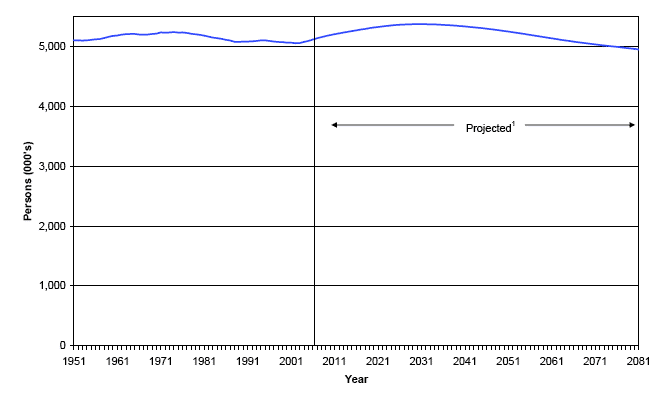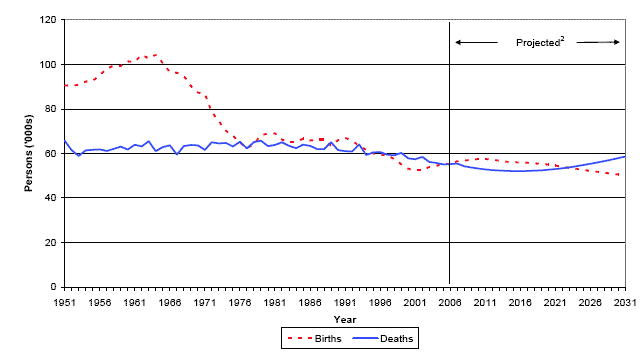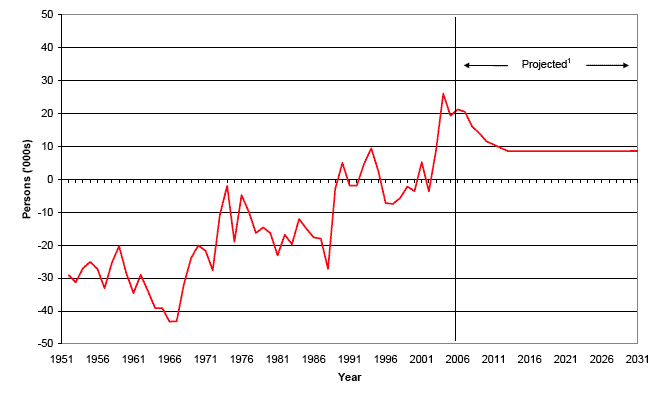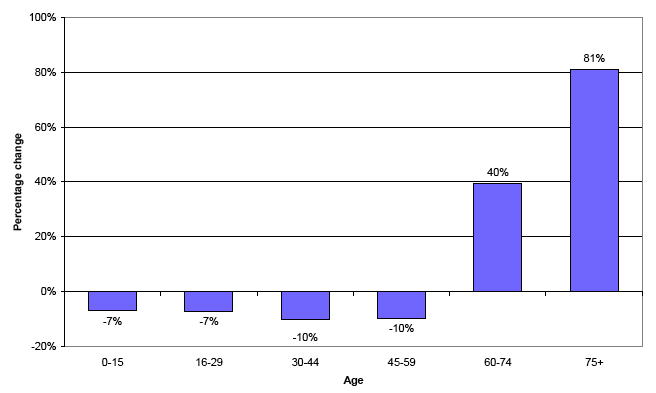
2.1 The results of this new set of projections, summarised in Table 1 and illustrated in Figure 1, show the total population of Scotland rising each year from 5.12 million in 2006 to 5.37 million in 2031 before declining after 2031 to 5.19 million in 2056. Scotland’s population is now projected to fall below 5 million in 2076, rather than 2036 as the last national projections suggested. It should be stressed that the 5 million mark holds no particular significance and does not represent an important population threshold. It should also be noted that the point at which the population reaches a particular level can be very sensitive to relatively small changes in the underlying assumptions, particularly when projected to occur so far in the future, and should therefore be treated with caution.
Figure 1 Estimated population of Scotland, actual and projected, 1951-2081

1 2006-based projection
2.2 Table 2 provides information on the projected components of change between 2006 and 2031. The table shows that up until around 2021 natural change and migration both act to increase the size of the population as the number of births exceeds the number of deaths and there is net in-migration. After this point the number of deaths exceeds the number of births whilst the net migration into Scotland continues. By 2031 the natural decrease more than cancels out the net in-migration and so Scotland’s population begins to fall.
Figure 2 Births and deaths, actual1 and projected, Scotland, 1951-2031

1 calendar year
2 2006-based mid-year projections
2.3 As Figure 2 shows, the number of births in Scotland fell significantly between the early 1960s and 2002 with the number of births dropping below the number of deaths in 1996. However, the last few years have seen an upturn in the number of births and this is projected to continue until 2011 with the number of births exceeding the number of deaths from 2007 (the first year of the projections) until 2023 when deaths once again outnumber births. Meanwhile the number of deaths is projected to fall until 2016 and then increase back to the levels experienced in the mid 1990s as a result of the increased number of older people.
Figure 3 Estimated and projected net migration, Scotland, 1951-2031

1 2006-based projections
2.4 As Figure 3 shows, Scotland has historically been a country of net out-migration with more people leaving than coming in the other direction. However, in the last few years Scotland has experienced record levels of net in-migration. As a result of these recent trends it has been assumed that Scotland will experience a net inflow throughout the projection period. The size of this net inflow is assumed to steadily fall for the first six years of the projection until it reaches 8,500 in 2012-13 and stays at this level for the remainder of the projection period. More detailed information on the fertility, mortality and migration assumptions leading to these results is given in Section 3 and Annex A, Annex B and Annex C.
2.5 A summary of projected populations by broad age groups is given in Table 3; projected populations by sex and five year age groups are given in Table 6. These tables and Figure 4 show that the age structure of the population is projected to change markedly between 2006 and 2031.
Figure 4 The projected percentage change in Scotland’s population by age group, 2006-2031

2.6 Scotland’s population is projected to increase by 5 per cent between 2006 and 2031. As Figure 4 shows the number of younger people is projected to decrease during this period whilst the number of older people is projected to increase significantly.
2.7 Between 2006 and 2031 the number of children aged under 16 is projected to decrease by 7 per cent from 0.92 million to 0.86 million.
2.8 During the same period the number of people of working age is projected to increase slightly from 3.21 million to 3.23 million (an increase of around 0.4 per cent) and the number of people of pensionable age is projected to rise from 0.98 million to 1.29 million (up by around 31 per cent).
2.9 These figures take into account the increases in the state pension age which will rise from 60 to 65 for women between 2010 and 2020 and then from 65 to 66 for both men and women between 2024 and 2026. A further increase to age 68 for both men and women will occur between 2034 and 2046. Were it not for these changes the population of working age would be projected to decrease by around 8 per cent and the population of pensionable age to increase by 58 per cent by 2031.
2.10 Among those of pensionable age the number of people aged 75 and over is projected to increase by around 81 per cent from 0.38 million in 2006 to 0.69 million in 2031 (this is in part due to the baby boomers born after the Second World War, in their early eighties by 2031, and the effect of improved mortality rates).
2.11 A useful summary measure of the age structure of a population is the dependency ratio - the ratio of persons aged under 16 or over pensionable age to those of working age. Table 4 shows that the dependency ratio is projected to rise very slowly from around 59 per 100 in 2006 to 62 per 100 in 2026. Between 2026 and 2031 the dependency ratio is projected to increase to 67 per 100 working age population. The relatively slow increase in the dependency ratio is partly due to the changes to the state pension age described above.
2.12 In 2006 the 59 dependents per 100 working age population were made up almost evenly of children (29 per 100) and pensioners (31 per 100). By 2031 this distribution is projected to have changed with 27 children and 40 pensioners per 100 population of working age. This in turn means that there will be relatively fewer people joining the working age population in subsequent years.